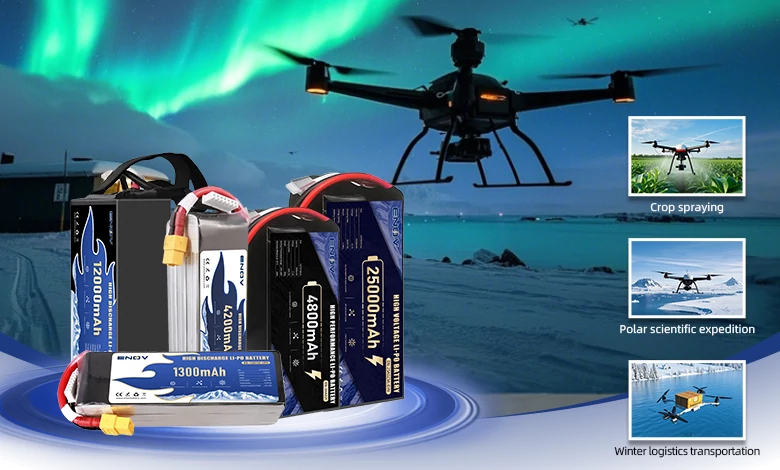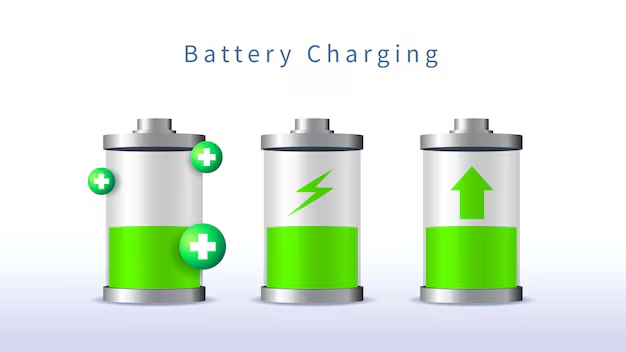Lithium Iron Phosphate (LiFePO₄) Lithium-Ion Batteries

ENOV High-Energy drone batteries power industrial and commercial drones. Delivering 220–320 Wh/kg energy density, they enable long flight times (30+ mins) and support fast charging (2C). Perfect for aerial photography, surveillance, and delivery drones.
1. Overall Battery Structure and Core Components
The performance and safety of lithium iron phosphate lithium-ion batteries (liquid electrolyte type) are determined by their sophisticated multi-layer structure and core components with clear functions. All parts work together to achieve the storage and release of electrical energy. The specific structure and component functions are as follows:
● Shell: Serving as the external protective barrier of the battery, its main role is to fix all internal components. Meanwhile, it isolates impurities such as moisture and dust in the external environment, preventing the internal structure from physical impact or chemical corrosion, and ensuring the structural integrity and operational safety of the entire battery.
● Electrode System: Divided into positive electrode and negative electrode, it is the core area where electrochemical reactions of the battery occur.
● Positive Electrode: It is made by mixing lithium iron phosphate (LiFePO₄) active material, conductive agent (e.g., carbon black), and binder (e.g., polyvinylidene fluoride) in a specific ratio, and then coating the mixture on the surface of an aluminum foil current collector. Among them, lithium iron phosphate, as the active material, is the key carrier for the intercalation and deintercalation of lithium ions, determining the core electrochemical properties of the battery such as capacity and voltage. The conductive agent is used to improve the electronic conductivity inside the positive electrode and reduce polarization. The binder firmly fixes the active material and the conductive agent on the current collector to prevent the active material from falling off.
● Negative Electrode: Usually, graphite (e.g., natural graphite, artificial graphite) is used as the active material, which is mixed with a conductive agent and a binder (e.g., styrene-butadiene rubber) and coated on the surface of a copper foil current collector. Graphite has a layered structure, which can stably accommodate the intercalation of lithium ions with small volume change, ensuring the structural stability of the battery during the cycling process. The copper foil current collector is responsible for collecting the electrons generated at the negative electrode and conducting them to the external circuit.
● Separator: A porous film located between the positive and negative electrodes, mostly made of polyethylene (PE), polypropylene (PP), or PE/PP composite film. Its core function is to physically separate the positive and negative electrodes to prevent direct contact between the two electrodes, which may cause a short circuit. At the same time, it allows lithium ions to freely migrate between the positive and negative electrodes through the pores of the film, providing an ion channel for electrochemical reactions. It is a key component to ensure battery safety and ion conduction efficiency.
● Liquid Electrolyte: Filled in the pores formed by the positive electrode, negative electrode, and separator, it consists of lithium salt (e.g., lithium hexafluorophosphate, LiPF₆) and organic solvents (e.g., a mixture of ethylene carbonate (EC), dimethyl carbonate (DMC), ethyl methyl carbonate (EMC) in a certain ratio). The lithium salt dissociates into lithium ions (Li⁺) in the organic solvent, and the lithium ions migrate between the positive and negative electrodes through the electrolyte to complete charge transfer. The organic solvent must have properties such as high dielectric constant, low viscosity, and good chemical stability. It not only ensures the full dissociation of the lithium salt but also avoids adverse reactions with the electrode materials.
2. Working Principle: Electrochemical Reactions During Charging and Discharging
The working process of a lithium iron phosphate lithium-ion battery is essentially a reversible electrochemical reaction in which lithium ions are intercalated into and deintercalated from the positive and negative electrodes, accompanied by the flow of electrons in the external circuit. It is specifically divided into two stages: charging and discharging.
(1) Charging Stage: "Migration and Storage" of Lithium Ions
During charging, the battery is connected to an external power source. The positive terminal of the power source provides electrons to the positive electrode of the battery, driving the positive electrode to undergo an oxidation reaction and the negative electrode to undergo a reduction reaction.
● Positive Electrode Reaction: Lithium iron phosphate (LiFePO₄) decomposes under the action of electrons, releasing lithium ions (Li⁺) and electrons (e⁻). The lithium ions move toward the negative electrode through the liquid electrolyte and across the separator. At the same time, the valence of iron in the positive electrode increases from +2 to +3, generating iron phosphate (FePO₄). The reaction formula can be expressed as: LiFePO₄ → Li⁺ + FePO₄ + e⁻.
● Electron Conduction: The electrons generated at the positive electrode cannot pass through the electrolyte (the electrolyte is an ionic conductor and does not conduct electricity). They need to flow from the positive electrode to the negative electrode through the external circuit (e.g., wires, electrical appliance interfaces) to provide electrical energy for the external circuit (the charging process is an electrical energy storage process, and the electron flow is driven by the power source).
● Negative Electrode Reaction: The electrons conducted to the negative electrode through the external circuit promote the layered structure of graphite at the negative electrode to undergo a reduction reaction. The lithium ions migrating from the positive electrode are intercalated between the graphite layers, forming a lithium-graphite intercalation compound (LiₓC₆). The reaction formula can be expressed as: xLi⁺ + C₆ + xe⁻ → LiₓC₆. At this point, the battery completes the conversion of electrical energy to chemical energy, realizing charge storage.
(2) Discharging Stage: "Release and Electrical Energy Output" of Lithium Ions
During discharging, the battery is connected to an external electrical appliance (e.g., electric vehicles, electronic products). The chemical energy stored in the negative electrode is converted into electrical energy to power the electrical appliance, and the reaction process is the reverse of the charging stage.
● Negative Electrode Reaction: The lithium-graphite intercalation compound (LiₓC₆) undergoes an oxidation reaction, releasing lithium ions (Li⁺) and electrons (e⁻). The lithium ions move toward the positive electrode through the liquid electrolyte and across the separator. The electrons flow to the electrical appliance through the external circuit to provide current for the electrical appliance, and then flow back to the positive electrode.
● Positive Electrode Reaction: The lithium ions migrating from the negative electrode and the electrons flowing back from the external circuit undergo a reduction reaction with iron phosphate (FePO₄) at the positive electrode. The lithium ions are re-intercalated into the crystal lattice of iron phosphate, and the valence of iron decreases from +3 to +2, regenerating lithium iron phosphate (LiFePO₄). The reaction formula can be expressed as: Li⁺ + FePO₄ + e⁻ → LiFePO₄. At this point, the battery completes the conversion of chemical energy to electrical energy, realizing electrical energy output.
During the charging and discharging process, the “intercalation-deintercalation” cycle of lithium ions between the positive and negative electrodes has high reversibility, which is the core reason for the battery’s long cycle life. Meanwhile, no metallic lithium is precipitated during the entire reaction process (under normal working conditions), so its safety is higher than that of traditional lithium-metal batteries.
3. Performance Characteristics: Analysis of Advantages and Limitations
Lithium iron phosphate lithium-ion batteries (liquid electrolyte type) exhibit significant advantages in performance due to their unique material properties and structural design, while also having certain limitations. The details are as follows:
(1) Core Advantages
● High Safety: The crystal structure of lithium iron phosphate, the positive electrode material, is stable. Under extreme working conditions such as high temperature, overcharging, extrusion, and puncture, it is not prone to structural collapse or oxygen release, avoiding the risk of violent reactions (e.g., combustion, explosion) with the electrolyte. Compared with ternary lithium-ion batteries, its thermal runaway temperature is higher (usually exceeding 200℃), and the incidence of fire and explosion accidents in practical applications is lower. It is the first choice for scenarios that prioritize safety (e.g., energy storage power stations, electric buses).
● Long Cycle Life: During the charging and discharging process, the lattice volume change rate of lithium iron phosphate is small (only about 3.7%), so the electrode material is not prone to falling off or pulverization due to repeated expansion and contraction. Meanwhile, the liquid electrolyte has good compatibility with the positive and negative electrode materials, and the electrolyte decomposition rate is slow after long-term cycling, resulting in a gentle attenuation of battery capacity. Under normal use conditions, its cycle life can reach more than 2000 times (capacity retention rate ≥ 80%), and some high-quality batteries can even exceed 5000 times, with a service life that can meet the application needs of more than 10 years.
● Good High-Temperature Stability: In high-temperature environments (e.g., outdoor conditions in summer, heat generation during fast charging of batteries), the chemical stability of lithium iron phosphate material is better than that of other positive electrode materials, and it is not prone to phase change or thermal decomposition. The liquid electrolyte can also improve its stability at high temperatures by optimizing the solvent ratio (e.g., increasing the proportion of high-boiling-point solvents), reducing the volatilization or decomposition of the electrolyte, and ensuring the performance and safety of the battery under high-temperature working conditions.
● Material Cost and Environmental Friendliness: The positive electrode material does not contain rare and precious metals such as cobalt and nickel. The raw materials (iron, phosphorus) are abundant in reserves and low in price, which greatly reduces the production cost of the battery. At the same time, there is less pollutant emission during the production process, and the recycling and disposal of the battery after scrapping are less difficult, which is environmentally friendly and conforms to the development trend of green energy.
(2) Main Limitations
● Low Energy Density: The theoretical specific capacity of lithium iron phosphate (about 170mAh/g) is lower than that of ternary positive electrode materials (e.g., the theoretical specific capacity of NCM811 is about 220mAh/g), and the working voltage of the battery is relatively low (nominal voltage is about 3.2V, while that of ternary batteries is about 3.7V), resulting in low volumetric energy density and mass energy density. Under the same weight or volume, the endurance capacity of lithium iron phosphate batteries is weaker than that of ternary batteries, which limits their application in scenarios with extremely high endurance requirements (e.g., high-end electric vehicles).
● Poor Low-Temperature Performance: In low-temperature environments (e.g., below -10℃), the viscosity of the liquid electrolyte increases, the migration rate of lithium ions slows down, and the resistance to lithium ion intercalation/deintercalation in the electrode material increases, resulting in a decrease in battery charge-discharge efficiency and a significant attenuation of capacity. For example, at -20℃, the capacity retention rate of lithium iron phosphate batteries may only be 50%-60% of that at room temperature, and the charging speed is greatly reduced, affecting the normal use of outdoor equipment in winter.
● Room for Improvement in Rate Performance: During high-rate charging and discharging (e.g., fast charging above 1C), large polarization will occur inside the battery, leading to a rapid voltage drop and increased heat generation. Although the rate performance can be improved by optimizing the electrode structure (e.g., reducing the particle size of the active material) and improving the electrolyte formula (e.g., adding conductive additives), the overall performance is still not as good as that of some high-rate ternary batteries. In scenarios that require rapid energy supplementation (e.g., fast-charging electric vehicles), the user experience is slightly inferior.
4. Application Fields: Scenario Adaptation Based on Performance Characteristics
Relying on its advantages of high safety, long service life, and low cost, lithium iron phosphate lithium-ion batteries (liquid electrolyte type) have been widely used in various fields. The specific scenarios are as follows:
● Energy Storage Field: Including large-scale energy storage power stations (e.g., grid peak shaving, new energy consumption energy storage) and distributed energy storage (e.g., household energy storage, industrial and commercial energy storage). Energy storage scenarios have extremely high requirements for battery safety, cycle life, and cost. The long cycle life of lithium iron phosphate batteries (which can meet the energy storage needs for more than 10 years), high safety (avoiding the fire risk of energy storage power stations), and low cost (reducing the investment in energy storage projects) make them the mainstream choice in the energy storage field. For example, many large-scale photovoltaic and wind power supporting energy storage projects in China all use lithium iron phosphate lithium-ion batteries.
● Electric Vehicle Field: Mainly used in mid-to-low-end passenger cars, electric buses, logistics vehicles, sanitation vehicles, etc. Commercial vehicles such as electric buses and logistics vehicles have relatively low requirements for endurance but are more sensitive to safety and cost. Lithium iron phosphate batteries can meet their daily operation needs. Some mid-to-low-end passenger cars (e.g., some BYD models) also use lithium iron phosphate batteries. By optimizing the battery pack structure (e.g., blade battery technology), they can improve safety while trying to make up for the shortage of low energy density.
● Portable Electronic Equipment Field: Suitable for equipment with high safety requirements and moderate endurance requirements, such as small power banks, emergency lights, and portable medical equipment (e.g., blood glucose meters, sphygmomanometers). Such equipment has a small volume and complex operating environments. The high safety of lithium iron phosphate batteries can prevent safety accidents caused by battery failures in the equipment, and their long cycle life can also extend the cycle of battery replacement for the equipment.
● Backup Power Supply Field: Used for backup power supplies of communication base stations, data centers, and emergency power supplies. Backup power supplies need to be in a floating charge state for a long time, which has high requirements for battery cycle life and stability. Lithium iron phosphate batteries have slow capacity attenuation under long-term floating charge and can quickly release electrical energy in case of power failure, ensuring the normal operation of key systems such as communication and data storage. For example, the backup power supplies of the three major communication operators in China have largely adopted lithium iron phosphate lithium-ion batteries to replace traditional lead-acid batteries.
Quick inquiry
Drop us a line, and we’ll get back to you within 24 hours.

Ariana Yuan
Digital Operations Manager
Website Planning|Marketing Project Management for Drone Batteries|Scheduled Content Refresh|SEO Optimization

Ariana Yuan
Digital Operations Manager
Website Planning|Marketing Project Management for Drone Batteries|Scheduled Content Refresh|SEO Optimization




